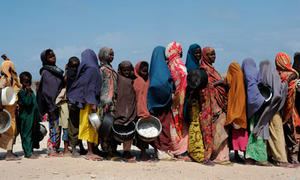African securityCentral African Republic, already mired in ethnic violence, faces another threat: famine
Since last year, when they had to flee the intensifying violence across the Central African Republic, farming communities had to abandon their fields along the main roads to replant deep in the bush. This disruption led them to produce much less than in previous years, with a major impact on their food reserves, which will last till February instead of July. The success of the next planting season crucially hinges on the return of farming families to the fields. Families who are unable to plant in March will have to wait one whole year before they can hope to harvest again. Failure to plant in March will have dire consequences for the food security of the Central African Republic’s population.

Famine threat looms large in war-torn Central African Republic // Source: huanqiu.com
Despite security challenges in half of the prefectures, farmers in the Central African Republic are counting on the next agriculture season to restore their food production capacity to avoid risks of famine and malnutrition. Since last year, when they had to flee the violence, farming communities had to abandon their fields along the main roads to replant deep in the bush. This disruption led them to produce much less than previous years with a major impact on their food reserves that will last till February instead of July.
The Food and Agriculture Organization (FAO) of the United Nations says it is already working to provide farmers with seeds and tools for the next campaign, but more funds are needed for the food security component of the 100-day response plan. Initial assessments conducted over the last week indicate a deteriorating situation in terms of low food stocks, widespread disruption to village food markets, and a lack of purchasing power overall among other issues, announced FAO.
“The combination of food shortages and poor sanitary conditions in the camps and deep in the bush, as well as extreme poverty, risk triggering serious malnutrition.” said Alexis Bonte, acting FAO Representative in the Central African Republic, following a visit to Bossangoa on Sunday, 29 December.
The success of the next planting season crucially hinges on the return of farming families to the fields. Families who are unable to plant in March will have to wait one whole year before they can hope to harvest again. Failure to help these families will have dramatic consequences on the food security for a quarter of the Central African population. The low production perceived from the last harvest coupled with a prevailing situation of chronic country-wide malnutrition is setting the stage for a full scale food and nutrition security crisis should the next planting season fail, reports the Organization today.
The FAO says that in response to the crisis, it has taken immediate action and set up a multidisciplinary team in Bangui, the country’s capital, with the support from its regional and subregional offices as well as headquarters. In the next few days, three sub-offices will be opened in the towns of Bossangoa, Bouar. and Bambari.
FAO and the World Food Program (WFP) are working closely together in implementing a 100-day response plan which they have developed to boost the humanitarian response to the most urgent needs. Within the 100 day response plan, FAO has identified priority areas for agriculture assistance, including the immediate resumption of agricultural production (seed distributions, restoration of communal storage facilities, and cash-for-work activities).
The FAO and WFP are seeking $61 million to help 1.8 million people. FAO has so far raised a total of $4. 3 million, including contributions from Belgium, Sweden, and the United States, as well as through its own emergency funding mechanisms.
